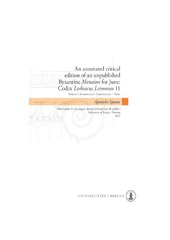| dc.description.abstract | The present thesis is an annotated critical edition of an unpublished collection of hymnographical texts. The collection, some of the texts of which was in use in the Byzantine and (later) the Orthodox Church between the 9th and the 17th c., is preserved in the 11th-12th-century Greek Manuscript 11 of the Library of Leimonos Monastery, on the island of Lesvos, Greece. This important codex is a Menaion for June comprising thirty akolouthiai on saints celebrated by the Orthodox Church. Twenty of these texts are hitherto unpublished. The introduction examines codex Lesb. Leimonos 11 and its importance from a palaeographical, liturgical, and hymnographical perspective. It is divided into four chapters. Chapter 1 presents briefly the liturgical environment of the period from the 9th c., when most of the texts edited were composed, to the 11th-12th, when the production of the codex could be placed. It also discusses the liturgical books used in the period, the structure of the akolouthiai and the festal calendar of the Byzantine Church. Chapter 2 deals with the content of the texts edited. The content of each of the akolouthiai is presented along with some information on the saints celebrated, hagiographical and liturgical texts related with them, and the composition of the akolouthiai. Chapter 3 presents briefly the life and the hymnographical work of the authors of the texts edited below, namely Joseph the Hymnographer, George of Nicomedia, Theophanes Graptos and Clement. Chapter 4 is devoted to the manuscript tradition of the texts. It comprises an analytical palaeographical and codicological description of codex Lesb. Leimonos 11, followed by the description of a closely related manuscript, codex Hierosolymitanus Sabaiticus 70, and a brief description of all manuscripts transmitting the texts edited, and an examination of their relations. The chapter closes with a brief note on the principles and conventions adopted in the present edition. The Commentary discusses liturgical, palaeographical, and hymnographical aspects of the edition. The thesis closes with full Bibliography and Plates with facsimiles of selected folios of manuscripts cited. The edition of the texts (Volume II) is preceded by a list of abbreviations and signs and is accompanied by an apparatus criticus and an apparatus fontium. Unpublished hymns and stanzas preserved in manuscripts other than Lesb. Leimonos 11 are included in the Appendices following the Texts. | en_US |

